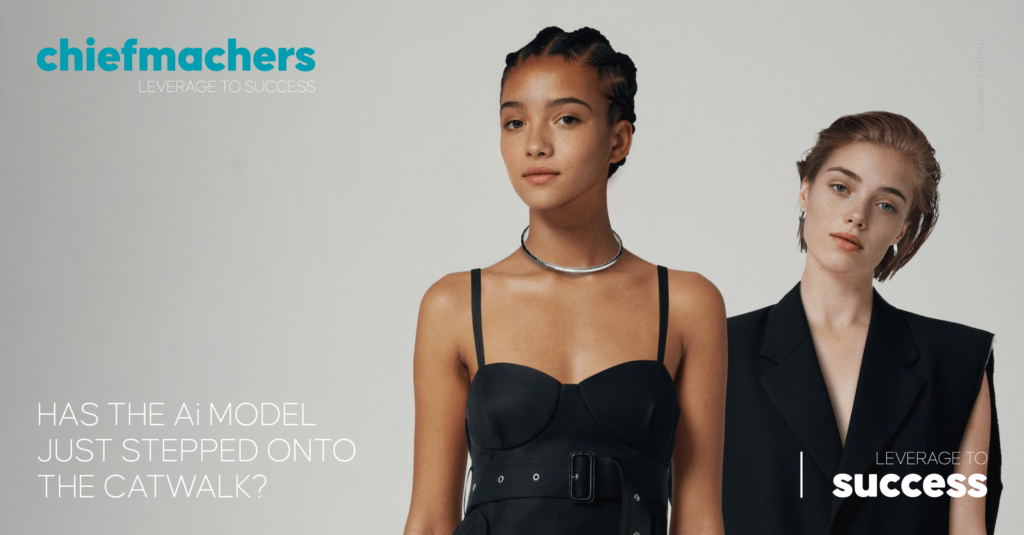This week we’re talking about the impact of Artificial Intelligence (AI) and how its introduction is causing various industries to change and adapt.
Today, we’re looking at the fashion industry and the rise of the AI model.

AI has made waves in the industry already, being used in the design process, to predict trends and even to elevate the in-store experience for customers.
Fashion, as an industry, is always innovating. It has, however, always had one constant in the human model. They have served as focal points for brands and some have even gone on to earn the fame and fortune associated with the ‘super model’.
Today, with the rise of AI, all of this may be about to change.
We have spoken about the impact of AI before. How does this translate to the fashion industry though? The answer might just be with virtual models – an emerging technology with the potential to reshape the way that fashion brands are both presented and experienced.
Real-world examples of the use of this technology are already among us. Levi’s and Calvin Klein have both made use of AI-generated models in e-commerce content and at a live show (respectively). They are taking advantage of new tech from startups such as Lalaland – an AI-powered digital model studio.
The natural jump to make here would be to suggest that this technology represents a serious threat to the future employment opportunities of human models. The argument made by industry leaders is a little more nuanced, though.
Amy Gershkoff Bolles, Levi’s global head of digital and emerging technology strategy, suggests that the use of virtual models is intended to “supplement” the work of existing models as opposed to being a replacement for them altogether.
“When we say supplement, we mean the AI-generated models can be used in conjunction with human models to potentially expand the number of models per product,” another spokesperson said.
One significant advantage of AI virtual models lies in their versatility and efficiency. Unlike their human counterparts, these digital creations do not require time-consuming casting, fittings or photo shoots. Instead, designers can rapidly design, modify and animate virtual personalities to showcase their latest collections. This streamlined process accelerates the production cycle, enabling quicker responses to evolving market trends and reducing time-to-market significantly.
Moreover, AI virtual models transcend physical limitations and can be seamlessly integrated into virtual and augmented reality experiences. By providing an immersive shopping environment, these digital avatars allow consumers to virtually “try on” clothing and accessories, facilitating confident purchasing decisions. This technology bridges the gap between online and offline shopping, opening up new avenues for brands to engage with their customers.
This is not the only example of AI technology infiltrating the world of fashion. ‘Virtual try-on’ is particularly common with eyewear brands. Personalised music in fitting rooms has also been trialled to boost the consumer experience. On the other end of the spectrum, brands have been using AI algorithms to forecast demand and to set pricing based on consumer behaviours.
AI making use of data-driven insights into consumer preferences is already proving hugely useful. Not least in the area of sustainability. Overproduction is fast becoming a thing of the past with data informing unit volumes. There are even some brands that will only produce products based on certain order numbers being met.
In this latest example, analysing engagement data on virtual models can provide actionable information about customer interests and expectations. Brands can leverage this information to inform their design choices and tailor marketing strategies, ultimately enhancing customer satisfaction and loyalty.
However, the use of AI virtual models raises ethical concerns regarding beauty standards and representation. The hyper-realistic portrayal of beauty by AI models could very easily perpetuate unrealistic beauty ideals, reinforcing harmful stereotypes. The responsible implementation of this technology will be imperative if it is to be seen as something that contributes positively to fashion’s future.
It is not beyond reason to picture a world where AI models come too close to the likenesses of real people. The legal implications could get very complex, very quickly with an individual’s data privacy in the balance.
Brands such as Lalaland suggest that their virtual model technology actually helps to avoid numerous ethical issues in fashion. On their website, they state that they are able to offer “a more inclusive, sustainable, and digital-minded brand. All with the help of generative AI.”
As virtual models step into the limelight, their deployment could well bring an unwanted lens onto an industry that has suffered from moral and identity crises in the past. Used in a more positive way, however, the opportunities for engaging, personalised experiences between consumer and brand are potentially endless.
The question may begin and end with the customers. How will they react? Will they be put off by the AI model or will the potential for more personalised, tailored experiences foster deeper brand affinity and, ultimately, increased spending?